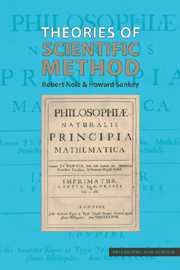Book contents
- Frontmatter
- Contents
- Abbreviations
- Acknowledgements
- Introduction
- I The idea of methodology
- II Inductive and hypothetico-deductive methods
- III Probability and scientific method
- 8 Probability, Bayesianism and methodology
- 9 Bayesianism: applications and problems
- IV Popper and his rivals
- V Naturalism, pragmatism, realism and methodology
- Epilogue
- Notes
- Bibliography
- Index
9 - Bayesianism: applications and problems
from III - Probability and scientific method
- Frontmatter
- Contents
- Abbreviations
- Acknowledgements
- Introduction
- I The idea of methodology
- II Inductive and hypothetico-deductive methods
- III Probability and scientific method
- 8 Probability, Bayesianism and methodology
- 9 Bayesianism: applications and problems
- IV Popper and his rivals
- V Naturalism, pragmatism, realism and methodology
- Epilogue
- Notes
- Bibliography
- Index
Summary
Chapter 8 set out some of the main principles of probability including Bayes's theorem and investigated the subjective interpretation of probability in terms of coherent degree of personal belief, ending with three core tenets of “pure (subjective) Bayesianism”. It also considered the ways in which Bayesianism captures a number of important aspects of scientific method, including an account of confirmation and disconfirmation and the good aspects of the hd method that survive within a probabilistic context, also providing it with a theory of confirmation. In this chapter we consider further successful applications of the probabilistic approach to methodology along with some problems for Bayesianism.
Section 9.1 considers the problem of priors that has oft en been thought to bedevil subjective Bayesianism. Is it sufficient for a theory of scientific method for one to simply adjust beliefs in accordance with the rules of the probability calculus? Section 9.2 considers whether subjective Bayesianism is incomplete and whether some additional principles are needed, even for those who adopt the subjectivist stance. Section 9.3 examines the account that Bayesianism can give of new evidence, and a problem it encounters with old evidence and how it might be overcome. Section 9.4 considers the successful account that Bayesianism can give of Kuhnian values. In §5.4 we outlined some accounts of inference to the best explanation (ibe). Since it is alleged that ibe is a rival to Bayesianism, §9.5 considers how well Bayesianism and ibe can accommodate one another.
Information
- Type
- Chapter
- Information
- Theories of Scientific MethodAn Introduction, pp. 220 - 250Publisher: Acumen PublishingPrint publication year: 2007
